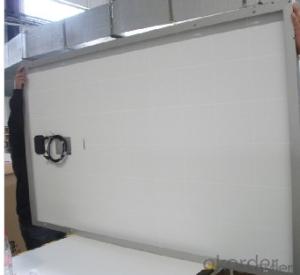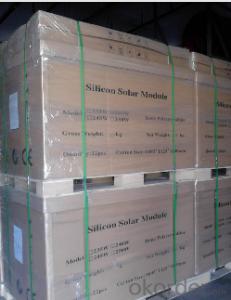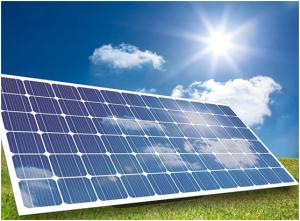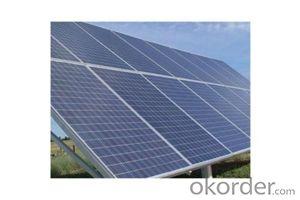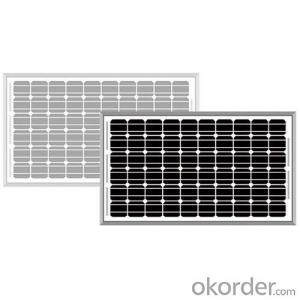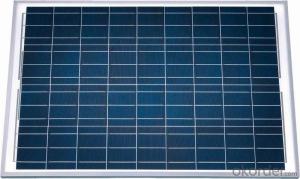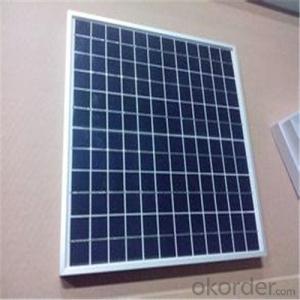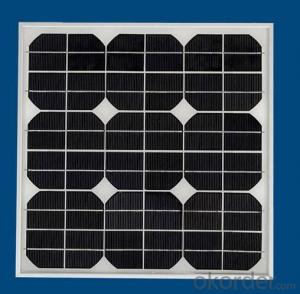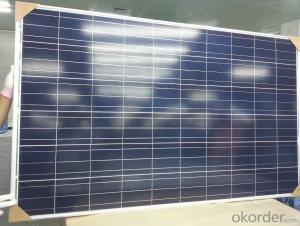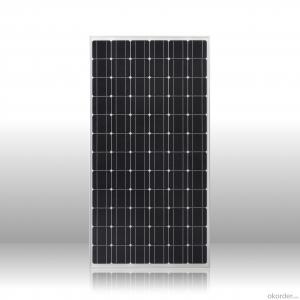300W Mono Solar Panels on A House
- Loading Port:
- Shanghai
- Payment Terms:
- TT or LC
- Min Order Qty:
- 1 pc
- Supply Capability:
- 1000000 pc/month
OKorder Service Pledge
OKorder Financial Service
You Might Also Like
Product Description:
Size: 1956*992*40mm
Power: 300W MONO
Cells: 72 cells 156mm
Certificagte: CE/CSA/TUV..
10 years warranty for materials and workmanship.
15 years (90%) and 25 years (80%) life time power output guaranteed.
SPECIFICATION:
Rated maximum power (Pmax) 300W
Open circuit voltage (vOC) 4.80
Short circuit current (Isc) 8.52
Maximum power voltage (Vmp) 36.10
Maximum power current (Imp) 8.32
Cell efficiency (%) 17.50%
Max system voltage (VDC) 1000V DC
Temperature coefficient of Vm -0.241%/K
Temperature coefficient of Im +0.03%/k
Temperature coefficient of power -0.37%/K
Maximum Series Fuse Rating 18A
Solar cell and configuratiou 72pcs(6*12)in series,156*156mm monocrystalline
Junction box IP65,1000VDC,TUV certified;6 pcs Schottky By-pass diodes
Cable type & CONNECTOR 4m㎡,TUV certificated,0.9m length;MC4
Encapsulation low iron tempered glass,3.2mm thickness,light transmission above 91%;TPT and fast cure EVA
Farame clear anodized aluminum alloy,50/45mm thickness,silver
Dimension (l*W*H) 1956*990*50mm/45mm
Weight 23.5KG/22.5KG
Heavy mechanical load salient features 5400Pa (ACCORDING TO ICE61215)
Hail impact test lce ball dianeter 25mm,23m/s
Operating temperature -40℃~+85 ℃
Standard test conditions: STC:AM=1.5,1000W/m2,cells temperature 25℃
Power tolerance:±3% (can be provided 0~±3%)
IMAGES: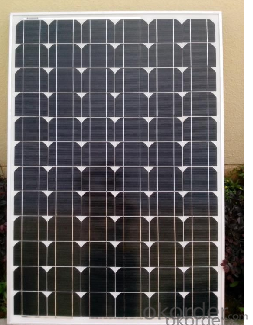
FAQ:WHAT'S THE ADVANTAGES OF CNBM?
1.CNBM is a state-owned company under jurisdiction of central goverment , one of Fortune 500 .Just because of this ,we can get more support and resources from our government.So ,it is realiable .
2.CNBM's solar products are high-qualified with TUV,UL,VDE,CE,ISO certificates. Our products ranges top in China.
3.Just as I mentioned in attahment ,we signed 500MW project with Urkan under the witness of our chairman Xi Jinping ,CNBM has ability to meet your large quantity needs,Our annual capacity is 1GW.
4.We can offer you a competitive price .Because you are our potential and valued customer .
- Q: I know absolutely nothing about electronics but have a lot of money. I am thinking of buying the Sunforce 3730 30W monocrystalline solar panel (the best I could find that was that size or smaller). What would be a good battery to go with it? I am thinking of buying a 2V Concorde Sun Xtender (again, the best I could find). But how many batteries will I need? I want enough batteries that it would take the solar panel 2 days to completely charge them from empty (bearing in mind the unavoidable inefficiencies like cloudiness/changing sun angles). Also, what other stuff would I need, like I hear something about a quot;charge controllerquot;? Any suggestions would be appreciated.
- If you are at a location/time where the panel will put out less power, you can adjust the battery size accordingly. And running a battery to empty is very bad for it's service life, so it's better to go a bit bigger.
- Q: Can solar panels be used for powering outdoor signage?
- Yes, solar panels can be used to power outdoor signage. Solar panels convert sunlight into electricity, providing a sustainable and renewable energy source for outdoor signage. This eliminates the need for traditional electricity sources, reduces energy costs, and minimizes the environmental impact.
- Q: I contend:As far as the solar panels causing global warming I'll try to explain. If you put a black panel on the ground or on your house and don't connect it to anything, it will absorb solar energy (heat) during daylight and release it at night (radiation). The net heat gain is zero. If you hook up a solar panel in the same place but hook it up to batteries, charge the batteries during sunlight hours and using that energy to electrically heat the home at night. The panels will absorb solar energy during the day but will convert that to electrical energy in the batteries instead of radiating it back into space at night. The result is a net gain in earth's temperature.Right or wrong?
- As far as it goes, you're right: putting up a big black object increases the total amount of energy absorbed from the sun. But that's only part of the story. If you didn't put up the solar panel, the same radiation would hit the earth. The earth already absorbs 2/3 or so of the energy that comes in (albedo .30), so adding even a perfectly black object increases it only by 50%. But it's not even that much, because most of the extra energy absorbed is converted into electricity. Solar panels are about 0-5% efficient, so half of the extra energy is turned into electricity rather than heat. Eventually it's put to use and turned into heat, but that heat was going to come from somewhere else anyway. (Even if it's just powering your DVD player, it turns into heat just the same as if you were using it to heat your house.) If you dig up a gallon of petroleum or fission a microgram of uranium, that's heat introduced into the earth's atmosphere. And these processes are inefficient: between generation and transmission you lose about 75% of the energy, meaning you've introduced 4 times as much energy into the atmosphere as you've actually used. So with a solar panel, you add extra heat to the earth by about 25% of incoming solar radiation, but you've offset external costs by about 45% of incoming solar radiation. The net effect is to cool the earth. And that assumes that the solar panel itself is perfectly black, which isn't the case. Real commercial solar panels have an albedo of about .35, which makes them more reflective than dirt and considerably more reflective than asphalt shingles, which have .03 albedo. In other words, even if you didn't actually use the solar panels for electricity, they'd be cooling the earth just by reflecting energy back into space more than your regular shingles.
- Q: Can solar panels be installed on wearable devices?
- Yes, solar panels can be installed on wearable devices. However, due to the limited surface area available on wearables, the amount of energy generated may be relatively low compared to larger solar installations. Additionally, the efficiency of such panels may vary based on the device's orientation to the sun. Nonetheless, incorporating solar panels on wearables can contribute to extending battery life and enhancing their overall sustainability.
- Q: Can solar panels be installed in areas with high pollution levels?
- Yes, solar panels can be installed in areas with high pollution levels. While pollution can reduce the efficiency of solar panels to some extent by blocking sunlight, they can still generate electricity even under such conditions. Regular maintenance and cleaning can help mitigate the impact of pollution on the performance of solar panels, making them a viable option even in areas with high pollution levels. Additionally, installing solar panels can help combat pollution by promoting the use of clean, renewable energy sources.
- Q: first of all, to be honest i have totally no idea on how a solar panel works.my task is to design something like a solar powered street lamp which store sun energy during day time and convert it into electrical energy then light energy so that the lamp can work during night time.any ideas on how to design the solar panel? which can store enough or more enegry in case there is no sunlight another day. and low cost as well :D
- image voltaic panels do no longer shop capability, they basically generate it. in case you opt to shop capability you like a battery economic enterprise of a few sort to get you for the time of the night and each time the sunlight isn't shining. in case you have somewhat extra in the fee selection you would be able to desire to look at a geothermal equipment to your place's heating and cooling needs. they are distinctly useful structures and you'd be able to supplement notwithstanding you like. notwithstanding you do, in spite of the indisputable fact that i'm hoping you have a sturdy construction envelope in place already. image voltaic panels are cool, yet once you have a leaky homestead, you're nevertheless no longer getting the final out of your panels. Do the extra mundane stuff first. Insulation, homestead windows, and climate-tight doorways.
- Q: can solar panels be on houses? malls?stores? WHAT ABOUT TRAINS?
- Hope This Helps!:)
- Q: Can solar panels be used to power a sports stadium?
- Yes, solar panels can be used to power a sports stadium. By installing a sufficient number of solar panels on the stadium's roof or surrounding areas, the captured solar energy can be converted into electricity to power various systems within the stadium, including lighting, heating, ventilation, and other electrical equipment. This can reduce the reliance on traditional energy sources and provide a more sustainable and environmentally friendly solution for powering sports stadiums.
- Q: Hey was looking at a 5 watt 2 volt solar panel and was wondering if it'd be enough to power a regular light bulb. Also need to power a 5volt 6.5 amp pump for at most a minute at a time. So basically if I had this panel would I be able to plug a lamp into it and have it light for 5+ hours at a time with the possibility of running the pump? If not what size panel would I need?
- The specifications you give say the solar panel produces 5 watts at 2 volts (DC) so that isn't enough voltage to power an ordinary (20-volt) light bulb. You could get 0 of these panels and connect them in series so they put out a total of 20 volts and the total power available would be 50 watts. The panels would light the bulb that way, provided the bulb isn't over 50 watts and you can afford the panels. A panel does provide enough power for a 2-volt car light bulb less than 5 watts. However, the maximum current you can get from these panels is .25 amperes (5 watts divided by 2 volts = .25 A.) This isn't enough power to run your pump which takes 6.5 amperes - at 20 volts, that would be 780 watts. Another thing to check is the pump motor; many electric motors are designed to run on AC only and will be damaged if you try to run DC through them. Remember solar panels produce DC so the raw output from a panel will not work on an AC motor.
- Q: I have just made my first dolar panel 20 watts, charges my 27TMX Trojan battery perfectly. Now I am thinking to build more solar panels for a grid tie installation at my house, maybe 5 panels would do it, is this safe?
- Homemade okorder
Send your message to us
300W Mono Solar Panels on A House
- Loading Port:
- Shanghai
- Payment Terms:
- TT or LC
- Min Order Qty:
- 1 pc
- Supply Capability:
- 1000000 pc/month
OKorder Service Pledge
OKorder Financial Service
Similar products
Hot products
Hot Searches
Related keywords

